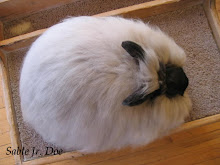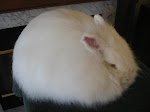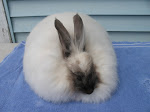-Another repost from the old blog:)
Many experienced rabbit raisers say that the real skill of a breeder lies not in their ability to breed, but in their ability to cull. If we sit down and really think about this, breeding becomes much more of a challenge than it may first appear because there are so many questions to ask about why we are doing what we are doing, and so many things to consider with the variables involved.
Genetic characteristics fall into two general categories, Qualitative and Quantitative. Qualitative traits are those which require only one or a few pairs of genes to express themselves, and Quantitative characteristics are influenced by many pairs of genes. Examples of traits that fall into the Qualitative category include wool color or the presence of wool itself (vs. fur), and examples of Quantitative traits include fertility, growth rate, milk production, wool density, and disease resistance. In other words, the improvement of quantitative traits is difficult and takes longer simply because there are so many genes at work producing effects that accumulate slowly over a much longer period of time (this principle is known as additive gene action).
Here are some portions of a great Table located in the 'Rabbit Production' book on pg. 326 which describes the heritability percentages for certain Quantitative traits. Much of the info. on this chart relates to meat production characteristics, but much of it also applies to the behaviors and traits of practically any rabbit breed. Several characteristics are listed along with a % of heritability for each trait according to the studies that were conducted:
Trait Percent Heritability (range according to various studies)
Litter Size born alive 2.1--10.0
Nest-building ability 24.0
Milk Production 27.0--45.5
Enteritis and Pnemonia deaths 12.0
Body weight: 1 day 40.0
30 days 17.0
56 days 22.6
70 days 12.0--38.0
77 days 19.0
Gain: 28-70 days 17.0
30-70 days 44.0
30-77 days 23.0
Loin Width (56 days): 60.0
There is another, more detailed Angora chart included in this book that breaks down the heritability of certain wool characteristics which I will post later this week. To boil the whole thing down simply---there are certain traits which are very easy to breed into a line, and others which are much more stubborn to set and require more deliberation and effort on the part of a breeder. Things like Milk Production or Growth Rate (which according to this chart are highly heritable), are easier to improve than something like 'Litter Size born alive', which is very vague and would depend very heavily on environmental variables.
I will post alot more on this topic since it is interesting and has alot of bearing on the traits we select for and how much progress we can expect to make in our breeding programs. 'Rabbit Production' sums it up very well on pg. 330 when it says, "the higher the heritability and the more intense the selection, the more rapid the expected rate of progress". If we manipulate traits that respond most readily and then cull hard to get the desired results in our herds, we cannot help but end up with litters that consistently outperform their parents (which is the goal of any good breeder, LOL:)).
Sunday, September 14, 2008
Subscribe to:
Post Comments (Atom)























No comments:
Post a Comment